Anhui
| Anhui Province 安徽省 | |
|---|---|
| Province | |
| Name transcription(s) | |
| • Chinese | 安徽省 (Ānhuī Shěng) |
| • Abbreviation | 皖 (pinyin: Wǎn) |
.svg.png) Map showing the location of Anhui Province | |
| Coordinates: 31°50′N 117°0′E / 31.833°N 117.000°ECoordinates: 31°50′N 117°0′E / 31.833°N 117.000°E | |
| Capital | Hefei |
| Largest city | Fuyang |
| Divisions | 16 prefectures, 105 counties, 1845 townships |
| Government | |
| • Secretary | Li Jinbin |
| • Governor | Li Guoying |
| Area[1] | |
| • Total | 139,600 km2 (53,900 sq mi) |
| Area rank | 22nd |
| Population (2013)[2] | |
| • Total | 60,300,000 |
| • Rank | 8th |
| • Density | 430/km2 (1,100/sq mi) |
| • Density rank | 9th |
| Demographics | |
| • Ethnic composition |
Han - 99% Hui - 0.6% |
| • Languages and dialects | Jianghuai Mandarin, Zhongyuan Mandarin, Gan, Wu, Huizhou |
| ISO 3166 code | CN-34 |
| GDP (2014) |
CNY 2.085 trillion US$ 339.38 billion (14th) |
| • per capita |
CNY 34,575 US$ 5,628 (26th) |
| HDI (2010) | 0.660[3] (medium) (25th) |
| Website | www.ah.gov.cn (simplified Chinese) |
| Anhui | |||||||||||||||||||||||||||||||||
|
"Anhui" in Chinese characters | |||||||||||||||||||||||||||||||||
| Chinese | 安徽 | ||||||||||||||||||||||||||||||||
|---|---|---|---|---|---|---|---|---|---|---|---|---|---|---|---|---|---|---|---|---|---|---|---|---|---|---|---|---|---|---|---|---|---|
| Literal meaning | "An[qing] and Hui[zhou cities]" | ||||||||||||||||||||||||||||||||
| |||||||||||||||||||||||||||||||||
Anhui ([ánxu̯éi̯]; Chinese: 安徽; pinyin: Ānhuī) is a landlocked province of the People's Republic of China located in the eastern region of the country. Located across the basins of the Yangtze River and the Huai River, it borders Jiangsu to the east, Zhejiang to the southeast, Jiangxi to the south, Hubei to the southwest, Henan to the northwest, and Shandong for a tiny section in the north. The provincial capital is Hefei.
The name "Anhui" derives from the names of two cities: Anqing and Huizhou (now Huangshan City).[4] The abbreviation for Anhui is "Chinese: 皖; pinyin: wǎn" after the historical State of Wan, Mount Wan, and the Wan river.
History
The province of Anhui was formed in the 17th century. Before then, there was no coherent concept of "Anhui". In terms of culture, Northern Anhui was firmly a part of the North China Plain together with modern-day Henan province, northern Jiangsu and southern Shandong provinces. Central Anhui was densely populated and constituted mostly of fertile land from the Huai River watershed. In contrast, the culture of Southern Anhui, bordered mostly along the Yangtze, was closer to Jiangxi and southern Jiangsu provinces. The hills of southeastern Anhui formed a unique and distinct cultural sphere of its own.
In the 2007 book China Road, author Rob Gifford stated that the Chinese refer to Anhui as a "big agricultural province" (农业大省). According to Gifford, this is an euphemism for a "very poor" area and that people have referred to Anhui as the "Appalachia of China."[5]
Geography

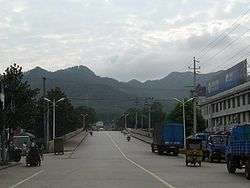
Anhui is quite diverse topographically. The north of the province is part of the North China Plain while the north-central areas are part of the Huai River watershed. Both of these regions are very flat and densely populated. The land becomes more uneven further south, with the Dabie Mountains occupying much of southwestern Anhui and a series of hills and ranges cutting through southeastern Anhui. The Yangtze River finds its way through south Anhui in between these two mountainous regions. The highest peak in Anhui is Lotus Peak, part of Huangshan in southeastern Anhui. It has an altitude of 1873 m.
Major rivers include the Huai River in the north and the Yangtze in the south. The largest lake is Lake Chaohu situated in the center of the province, with an area of about 800 km2 (310 sq mi). The southeastern part of the province near the Yangtze River has many lakes as well.
As with topography, the province differs in climate from north to south. The north is more temperate and has more clearcut seasons. January temperatures average at around -1 to 2 °C north of the Huai River, and 0 to 3 °C south of the Huai River; in July temperatures average 27 °C or above. Plum rains occur in June and July and may cause flooding.
Major cities:
Administrative divisions
Anhui is divided into sixteen prefecture-level divisions: all prefecture-level cities:
| Administrative divisions of Anhui | ||||||||||
|---|---|---|---|---|---|---|---|---|---|---|
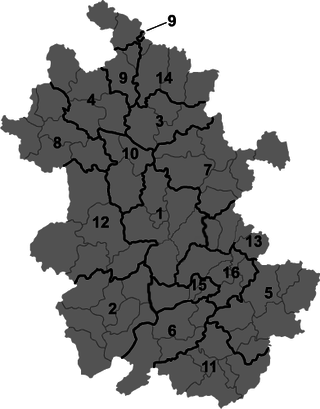 | ||||||||||
| № | Division code[6] | English name | Chinese | Pinyin | Area in km2[7] | Population 2010[8] | Seat | Divisions[9] | ||
| Districts | Counties | CL cities | ||||||||
| 340000 | Anhui | 安徽省 | Ānhuī Shěng | 139600.00 | 59,500,510 | Hefei | 44 | 55 | 6 | |
| 1 | 340100 | Hefei | 合肥市 | Héféi Shì | 11429.68 | 7,457,000 | Shushan District | 4 | 4 | 1 |
| 16 | 340200 | Wuhu | 芜湖市 | Wúhú Shì | 6026.05 | 3,443,000 | Jiujiang District | 4 | 4 | |
| 3 | 340300 | Bengbu | 蚌埠市 | Bèngbù Shì | 5952.13 | 3,164,000 | Bengshan District | 4 | 3 | |
| 10 | 340400 | Huainan | 淮南市 | Huáinán Shì | 5569.96 | 2,334,000 | Tianjia'an District | 5 | 2 | |
| 13 | 340500 | Ma'anshan | 马鞍山市 | Mǎ'ānshān Shì | 4049.13 | 2,304,000 | Yushan District | 3 | 3 | |
| 9 | 340600 | Huaibei | 淮北市 | Huáiběi Shì | 2740.91 | 2,114,000 | Xiangshan District | 3 | 1 | |
| 15 | 340700 | Tongling | 铜陵市 | Tónglíng Shì | 2924.00 | 1,562,670 | Tongguan District | 3 | 1 | |
| 2 | 340800 | Anqing | 安庆市 | Ānqìng Shì | 13538.00 | 4,472,667 | Yingjiang District | 3 | 6 | 1 |
| 11 | 341000 | Huangshan | 黄山市 | Huángshān Shì | 9678.84 | 1,359,000 | Tunxi District | 3 | 4 | |
| 7 | 341100 | Chuzhou | 滁州市 | Chúzhōu Shì | 13523.22 | 3,938,000 | Langya District | 2 | 4 | 2 |
| 8 | 341200 | Fuyang | 阜阳市 | Fùyáng Shì | 10122.77 | 7,600,000 | Yingzhou District | 3 | 4 | 1 |
| 14 | 341300 | Suzhou | 宿州市 | Sùzhōu Shì | 9939.80 | 5,353,000 | Yongqiao District | 1 | 4 | |
| 12 | 341500 | Lu'an | 六安市 | Lù'ān Shì | 12461.45 | 5,612,000 | Jin'an District | 3 | 4 | |
| 4 | 341600 | Bozhou | 亳州市 | Bózhōu Shì | 8522.58 | 4,851,000 | Qiaocheng District | 1 | 3 | |
| 6 | 341700 | Chizhou | 池州市 | Chízhōu Shì | 8391.73 | 1,403,000 | Guichi District | 1 | 3 | |
| 5 | 341800 | Xuancheng | 宣城市 | Xuānchéng Shì | 12323.43 | 2,533,000 | Xuanzhou District | 1 | 5 | 1 |
The sixteen prefecture-level divisions of Anhui are subdivided into 105 county-level divisions (44 districts, 6 county-level cities, and 55 counties). Those are in turn divided into 1,845 township-level divisions (972 towns, 634 townships, nine ethnic townships, and 230 subdistricts).
Politics
The Politics of Anhui Province is structured in a dual party-government system like all other governing institutions in mainland China.
The Governor of Anhui (安徽省省长) is the highest-ranking official in the People's Government of Anhui. However, in the province's dual party-government governing system, the Governor has less power than the Anhui Communist Party of China Provincial Committee Secretary (安徽省委书记), colloquially termed the "Anhui Party Chief".
Economy
Agriculture in Anhui varies according to the climate zones that the province crosses. To the north of the Huai River, wheat and sweet potatoes are grown, while to the south of the Huai River it is rice and wheat instead.
Natural resources of Anhui include iron in Ma'anshan, coal in Huainan, and copper in Tongling. There are industries related to these natural resources (e.g. steel industry at Ma'anshan). One of the famous Anhui-based corporations is the automobile company Chery, which is based in Wuhu.
Compared to its more prosperous neighbours to the east, Zhejiang and Jiangsu, Anhui has lagged markedly behind in economic development, with a GDP per capita around one third the level of those two provinces. There is great regional disparity as well, and most of the wealth is concentrated in industrial regions close to the Yangtze River, such as Hefei, Wuhu, and Ma'anshan.
Anhui's nominal GDP for 2011 was approximately 1.51 trillion yuan (US$239.8 billion), up 12.9% from 2008 and a per capita of 16,391 yuan (US$2,400). It is considered a mid-size economy in terms of economic output. Anhui's GDP is largely driven by fixed-asset investment, and the province's GDP to FAI ratio as of 2009 was 0.89, the highest in China.[10]
Anhui's largest companies include Anhui Conch Cement Company, a producer and distributor of cement, Guoyang Securities Co (SHE: 000728), a financial services provider, and Ma’anshan Iron & Steel, a producer of steel and iron.[11]
Major Economic and Technological Development Zones
Hefei Economic and Technological Development Zone
Hefei Economic and Technological Development Zone is located in the southwest of Hefei. The zone is divided into two functional areas. The east part is allocated for manufacturing purpose and it also has two parks; the west part is where the business center, Hefei university town, and the international community center are located. It is established in 1993, and it is located close to Hefei Luogang International Airport.[12]
Hefei Hi-Tech Industrial Development Zone
Hefei Hi-Tech Industrial Development Zone was founded in October 1990 and approved by the State Council as a state-level Development Zone in March 1991. In 1997, the Development Zone was ratified as an APEC Science and Technology Industrial Park, with special open policies to APEC and EU members. Hefei High Tech Park was also approved as a National High Tech Export Base in 2000 and obtained the award of an Advanced High Tech Zone under the Torch Program in 2003. So far, more than 100 hi-tech enterprises have entered the zone. Industries encouraged in the zone include Chemicals Production and Processing, Electronics Assembly & Manufacturing, Heavy Industry, Instruments & Industrial Equipment Production, Medical Equipment and Supplies, Research and Development, Telecommunications Equipment.[13]
Wuhu Economic and Technological Development Zone
Established in 1993, Wuhu Economic & Technological Development Zone is the first state-level development zone approved by central government in Anhui Province. As the hub in the west of the Yangtze Delta, it is an ideal place for business in Central China and East China such as manufacturing place or logistic center due to great transportation advantage. Wuhu port is the last fine deepwater port here going against the Yangtse River. It is the main foreign trade base and overseas transportation center. It takes 1 hour from Wuhu to Nanjing Lukou International Airport and to Hefei Luogang Airport.[14]
Wuhu Export Processing Zone
Wuhu Export Processing Zone was approved to be a national level export processing zone by State Council. Wuhu Export Processing Zone is located in the Wuhu EDZ, with a total planned area of 2.95 km2 with the first-stage are being 1.1 km2. It is located close to Wuhu Airport and Wuhu Port. Industries encouraged in the zone include Electronics Assembly & Manufacturing, Heavy Industry, Instruments & Industrial Equipment Production, Shipping/Warehousing/Logistics, Trading and Distribution.[15]
Transportation
Historically, Anhui's transport network was hampered by the lack of bridges across the Yangtze River, which divides the province into northern and southern regions. The first bridge across the Yangtze in Anhui, the Tongling Yangtze River Bridge was completed in 1995. As of October 2014, Anhui had four bridges across the Yangtze, at Ma'anshan, Wuhu, Tongling, and Anqing.
Rail
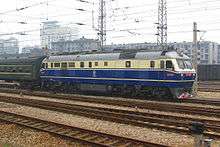
Conventional railways in Anhui include the Beijing–Shanghai Railway, Beijing–Kowloon Railway, and Nanjing–Xi'an Railway that traverse the province north of the Yangtze River and the Nanjing−Tongling Railway, Anhui–Jiangxi Railway and Xuancheng–Hangzhou Railway that run south of the river.
High-speed lines include Beijing-Shanghai High-Speed Railway, Hefei–Wuhan Passenger Railway and Hefei–Nanjing Passenger Railway.
Demographics
| Historical population | ||
|---|---|---|
| Year | Pop. | ±% |
| 1912[16] | 16,229,000 | — |
| 1928[17] | 21,715,000 | +33.8% |
| 1936-37[18] | 23,354,000 | +7.5% |
| 1947[19] | 22,462,000 | −3.8% |
| 1954[20] | 30,343,637 | +35.1% |
| 1964[21] | 31,241,657 | +3.0% |
| 1982[22] | 49,665,724 | +59.0% |
| 1990[23] | 56,180,813 | +13.1% |
| 2000[24] | 58,999,948 | +5.0% |
| 2010[25] | 59,500,510 | +0.8% |
Han Chinese make up the vast majority of the population. The Hui and She nationalities are the two largest minorities.
Anhui has a highly unbalanced gender ratio. According to a 2009 study published in the British Medical Journal, in the 1-4 age group, there are 138 boys for every 100 girls, making it among the most unbalanced of provinces in China.[26]
Culture
Anhui spans many geographical and cultural regions. The northern, flatter parts of the province, along the Huai River and further north, are most akin to neighbouring provinces like Henan, Shandong and northern Jiangsu. In contrast, the southern, hilly parts of the province are more similar in culture and dialect to other southern, hilly provinces, like Zhejiang and Jiangxi.
Mandarin dialects are spoken over the northern and central parts of the province, north of the Yangzi river. Dialects to the north (e.g. Bengbu dialect) are classified as Zhongyuan Mandarin, together with dialects in provinces such as Henan and Shandong; dialects in the central parts (e.g. Hefei dialect) are classified as Jianghuai Mandarin, together with dialects in the central parts of neighbouring Jiangsu province. Non-Mandarin dialects are spoken to the south of the Yangzi: dialects of Wu are spoken in Xuancheng prefecture-level city, though these are rapidly being replaced by Jianghuai Mandarin; dialects of Gan are spoken in a few counties in the southwest bordering Jiangxi province;[27] and the Huizhou dialects are spoken in about ten counties in the far south, a small but highly diverse and unique group of Chinese dialects.
Huangmeixi, which originated in the environs of Anqing in southwestern Anhui, is a form of traditional Chinese opera popular across China. Huiju, a form of traditional opera originating in the Huizhou-speaking areas of southern Anhui, is one of the major precursors of Beijing Opera; in the 1950s, Huiju (which had disappeared) was revived. Luju is a type of traditional opera found across central Anhui, from east to west.
Anhui cuisine is one of the eight great traditions of Chinese cuisine. Combining elements of cooking from northern Anhui, south-central Anhui, and the Huizhou-speaking areas of southern Anhui, Anhui cuisine is known for its use of wild game and herbs, both land and sea, and comparatively simple methods of preparation.
Anhui has a high concentration of traditional products related to calligraphy: Xuanzhou (today Xuancheng) and Huizhou (today Huangshan City) are revered for producing Xuan Paper and Hui Ink, respectively, which are traditionally considered the best types of paper and ink for Chinese calligraphy. She County is famous for the She Inkstone, one of the most preferred types of inkstones (a required tool in traditional calligraphy).
Religion
The predominant religions in Anhui are Chinese folk religions, Taoist traditions and Chinese Buddhism. According to surveys conducted in 2007 and 2009, 4.64% of the population believes and is involved in ancestor veneration, while 5.30% of the population identifies as Christian.[28] According to a 2010 survey, Muslims constitute 0.58% of the population of Anhui .[29]
The reports didn't give figures for other types of religion; 89.48% of the population may be either irreligious or involved in worship of nature deities, Buddhism, Confucianism, Taoism and folk religious sects.
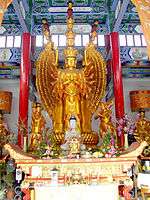

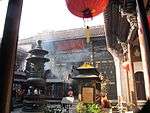
Tourism
Anhui's principal tourism sites include the following:
- Ancient Villages in Southern Anhui - Xidi and Hongcun (World Heritage Site).
- Chao Lake
- Jing Ting Mountain
- Mount Huangshan (World Heritage Site)
- Mount Jiuhua
- Mount Langya
- Mount Qiyun
- Mount Tianzhu
- Old Town of Tunxi
- Taiji Cave, the longest karst cave in East China.
- Zhenfeng Pagoda, a Ming Dynasty pagoda in Anqing City.
- Zuiweng Pavilion, named after the poet Ouyang Xiu (1007−1072 CE).
Development
In 2008, France helped the Anhui Provincial Tourism Bureau develop a rural tourism demonstration project.[30]
Notable people
- Gao Yao (皋陶) (lived in the 21st century BCE), political advisor of the Yu the Great.
- Guan Zhong (管仲) (720-645 BC), Prime Minister of Duke Huan of Qi.
- Zhuang Zi (庄子) (369-286 BC), philosopher of Taoism.
- Fan Zeng (范增) (277-204 BC), advisor to Xiang Yu.
- Zhang Liang (张良) (262–189 BC), strategist and statesman of the early Han dynasty.
- Liu An (刘安) (179-122 BC), King of Huainan.
- Hua Tuo (华陀) (140-208), physician.
- Cao Cao (曹操) (155-220), warlord and the penultimate chancellor of the Eastern Han dynasty.
- Cao Pi (曹丕) (187-226), Emperor Wen of Wei, first emperor of the state of Cao Wei.
- The Three Kingdoms era Cao Wei generals Cao Ren (曹仁), Cao Hong (曹洪), Xiahou Dun (夏侯惇), Xiahou Yuan (夏侯渊), Cao Zhen (曹真).
- The Three Kingdoms era Sun Wu generals Zhou Yu (周瑜), Lu Su (鲁肃), Lü Meng (吕蒙).
- Ji Kang (嵇康) (223–262), musician, author, poet.
- Huan Wen (桓温) (312–373), general of the Jin Dynasty.
- Huan Xuan (桓玄) (369–404), founder of the state of Huan Chu.
- Zhu Wen(朱温) (852–912), founder of Later Liang.
- Yang Xingmi (杨行密) (852–905), founder of the state of Wu (Ten Kingdoms).
- Bao Zheng (包拯) (999–1062),a famous upright official of Northern Song dynasty.
- Li Gonglin (李公麟) (1049–1106), painter.
- Zhu Xi (朱熹) (1130–1200), philosopher of Neo-Confucianism.
- Zhu Yuanzhang (朱元璋) (1328–1398), Hongwu Emperor, founder and first emperor of the Ming dynasty.
- The Ming dynasty generals Xu Da (徐达), Chang Yuchun (常遇春), Tang He (汤和), Mu Ying (沐英).
- Hong Ren (弘仁), painter.
- Zhang Tingyu (张廷玉), politician and historian of Qing dynasty.
- Yao Nai (姚鼐), main figure of Tongcheng School of Qing dynasty.
- Wu Jingzi (吴敬梓) (1701—1754), novelist.
- Dai Zhen (戴震) (1724–1777), a notable scholar.
- Cheng Changgeng (程长庚) (1811-1880), one of the founders of Beijing opera.
- Li Hongzhang (李鸿章) (1823–1901), leading statesman of the late Qing Empire.
- Liu Mingchuan (刘铭传) (1836–1896), first governor of the province of Taiwan.
- Jeme Tien Yow (詹天佑) (1861–1919), famous Chinese railroad engineer.
- Duan Qirui (段祺瑞) (1865–1936), warlord and politician, commander in the Beiyang Army.
- Bai Wenwei (柏文尉) (1876–1947), scholar, Kuomintang (KMT) General, Governor of Anhui (1912–13)
- Feng Yuxiang (冯玉祥) (1882–1948), warlord and leader in Republican China.
- Hu Shih (胡适) (1891–1962), philosopher, essayist and diplomat.
- Zhang Zhizhong (张治中) (1895–1969), Kuomintang (KMT) General.
- Wei Lihuang (卫立煌) (1897–1960), Kuomintang (KMT) General.
- Sun Li-jen (孙立人) (1900–1990), Kuomintang (KMT) General.
- Tao Xingzhi (陶行知) (1891–1946), a renowned Chinese educator and reformer.
- Chen Duxiu (陈独秀) (1879–1942), co-founder of the Chinese Communist Party.
- Wang Ming (王明) (1904–1974), senior leader of the early Chinese Communist Party.
- Wang Jiaxiang (王稼祥) (1906–1974), one of the senior leaders of the early Communist Party of China.
- Li Kenong (李克农) (1899–1962), a major figure of Chinese Communist intelligence.
- Ke Qingshi (柯庆施) (1902–1965)
- Zhu Guangqian (朱光潜), founder of the study of aesthetics in 20th-century China.
- Zhao Puchu (赵朴初) (1907–2000), religious and public leader.
- Yu Ying-shih (余英时), Chinese American historian.
- Yan Fengying (严凤英), performing artist of Huangmei opera.
- Huang Binhong (黄宾虹), painter.
- Wu Zuoren (吴作人), painter.
- Deng Jiaxian (邓稼先), leading organizer and key contributor to the Chinese nuclear weapon programs.
- Chen Ning Yang (杨振宁), Chinese-American physicist who won the 1957 Nobel prize in physics.
- Xu Haifeng (许海峰), first person to win a gold medal for China in the Olympic Games.
- Jin Jing
- Hu Jintao (胡锦涛), former General Secretary of the Communist Party of China, President of the People's Republic of China
- Li Keqiang (李克强)
- Zhao Wei (赵薇) actress, pop singer, and film director.
- Deng Linlin (邓琳琳), Olympic gold medal winning gymnast.
Colleges, universities and research institutions
- Anhui Agricultural University, in Hefei
- Anhui Medical University
- Anhui Normal University, in Wuhu
- Anhui University, in Hefei
- Anhui University of Finance and Economics, in Bengbu
- Anhui University of Technology, in Ma'anshan
- Anhui University of Technology and Science, in Wuhu City
- Anhui University of Traditional Chinese Medicine
- Anhui University of Science & Technology, in Huainan
- Anqing Teachers College, in Anqing
- Hefei Normal University, in Hefei
- Hefei University of Technology
- University of Science & Technology of China, located in the Southwest part of Hefei
- Wannan Medical College, in Wuhu City
- Hefei Institutes of Physical Science, Chinese Academy of Sciences in Hefei
See also
Notes
- ↑ The data was collected by the Chinese General Social Survey (CGSS) of 2009 and by the Chinese Spiritual Life Survey (CSLS) of 2007, reported and assembled by Xiuhua Wang (2015)[28] in order to confront the proportion of people identifying with two similar social structures: ① Christian churches, and ② the traditional Chinese religion of the lineage (i. e. people believing and worshipping ancestral deities often organised into lineage "churches" and ancestral shrines). Data for other religions with a significant presence in China (deity cults, Buddhism, Taoism, folk religious sects, Islam, et. al.) was not reported by Wang. The number of Muslims is taken from a survey reported in the year 2010.[29]</ref>
Other religions or not religious people<ref group='note'>This may include:
- Buddhists;
- Confucians;
- Deity worshippers;
- Taoists;
- Members of folk religious sects;
- And people not bounded to, nor practicing any, institutional or diffuse religion.
References
- ↑ "Doing Business in China - Survey". Ministry Of Commerce - People's Republic Of China. Retrieved 5 August 2013.
- ↑ "Communiqué of the National Bureau of Statistics of People's Republic of China on Major Figures of the 2010 Population Census [1] (No. 2)". National Bureau of Statistics of China. 29 April 2011. Archived from the original on 27 July 2013. Retrieved 4 August 2013.
- ↑ 《2013中国人类发展报告》 (PDF) (in Chinese). United Nations Development Programme China. 2013. Retrieved 2014-05-14.
- ↑ (Chinese) Origin of the Names of China's Provinces, People's Daily Online.
- ↑ Gifford, Rob. "A Single Spark Can Light a Prairie Fire." China Road. 53.
- ↑ "中华人民共和国县以上行政区划代码". 中华人民共和国民政部.
- ↑ 深圳市统计局. 《深圳统计年鉴2014》. 深圳统计网. 中国统计出版社. Retrieved 2015-05-29.
- ↑ shi, Guo wu yuan ren kou pu cha ban gong; council, Guo jia tong ji ju ren kou he jiu ye tong ji si bian = Tabulation on the 2010 population census of the people's republic of China by township / compiled by Population census office under the state; population, Department of; statistics, employment statistics national bureau of (2012). Zhongguo 2010 nian ren kou pu cha fen xiang, zhen, jie dao zi liao (Di 1 ban. ed.). Beijing Shi: Zhongguo tong ji chu ban she. ISBN 978-7-5037-6660-2.
- ↑ 中华人民共和国民政部 (2014.08). 《中国民政统计年鉴2014》. 中国统计出版社. ISBN 978-7-5037-7130-9. Check date values in:
|date=(help) - ↑ "Anhui Province: Economic News and Statistics for Anhui's Economy". Thechinaperspective.com. Retrieved 2013-04-10.
- ↑ "Anhui Province Economic News and Data". The China Perspective. Retrieved 2013-04-10.
- ↑ "Hefei Economic and Technological Development Zone". RightSite.asia. Retrieved 2013-04-10.
- ↑ "Hefei Hi-Tech Industrial Development Zone". RightSite.asia. Retrieved 2013-04-10.
- ↑ RightSite.asia | Wuhu Economic & Technological Development Zone
- ↑ "Wuhu Export Processing Zone". RightSite.asia. Retrieved 2013-04-10.
- ↑ "1912年中国人口". Retrieved 6 March 2014.
- ↑ "1928年中国人口". Retrieved 6 March 2014.
- ↑ "1936-37年中国人口". Retrieved 6 March 2014.
- ↑ "1947年全国人口". Retrieved 6 March 2014.
- ↑ "中华人民共和国国家统计局关于第一次全国人口调查登记结果的公报". National Bureau of Statistics of China. Archived from the original on 2009-08-05.
- ↑ "第二次全国人口普查结果的几项主要统计数字". National Bureau of Statistics of China. Archived from the original on 2012-09-14.
- ↑ "中华人民共和国国家统计局关于一九八二年人口普查主要数字的公报". National Bureau of Statistics of China. Archived from the original on 2012-05-10.
- ↑ "中华人民共和国国家统计局关于一九九〇年人口普查主要数据的公报". National Bureau of Statistics of China. Archived from the original on 2012-06-19.
- ↑ "现将2000年第五次全国人口普查快速汇总的人口地区分布数据公布如下". National Bureau of Statistics of China. Archived from the original on 2012-08-29.
- ↑ "Communiqué of the National Bureau of Statistics of People's Republic of China on Major Figures of the 2010 Population Census". National Bureau of Statistics of China. Archived from the original on 2013-07-27.
- ↑ "China's excess males, sex selective abortion, and one child policy: analysis of data from 2005 national intercensus survey". BMJ. Retrieved 2013-04-10.
- ↑ Damian Harper; Chung Wah Chow; David Eimer; Thomas Huhti; Carolyn B. Heller; Robert Kelly (2009). China (11, illustrated ed.). Lonely Planet. p. 437. ISBN 1-74104-866-4. Retrieved 23 September 2011.
- 1 2 3 China General Social Survey 2009, Chinese Spiritual Life Survey (CSLS) 2007. Report by: Xiuhua Wang (2015, p. 15)
- 1 2 Min Junqing. The Present Situation and Characteristics of Contemporary Islam in China. JISMOR, 8. 2010 Islam by province, page 29. Data from: Yang Zongde, Study on Current Muslim Population in China, Jinan Muslim, 2, 2010.
- ↑ Anhui Cooperates With France To Build Rural Tourism Area Archived September 8, 2008, at the Wayback Machine.
External links
| Wikivoyage has a travel guide for Anhui. |
| Wikimedia Commons has media related to Anhui. |
- Anhui Government website
- Anhui Provincial Tourism Administration Official Site
- Economic profile for Anhui Province at HKTDC
 Chisholm, Hugh, ed. (1911). "Ngan-hui". Encyclopædia Britannica (11th ed.). Cambridge University Press.
Chisholm, Hugh, ed. (1911). "Ngan-hui". Encyclopædia Britannica (11th ed.). Cambridge University Press.
 |
Henan | Shandong | Jiangsu |  |
| |
||||
| ||||
| | ||||
| Hubei | Jiangxi | Zhejiang |
.svg.png)

